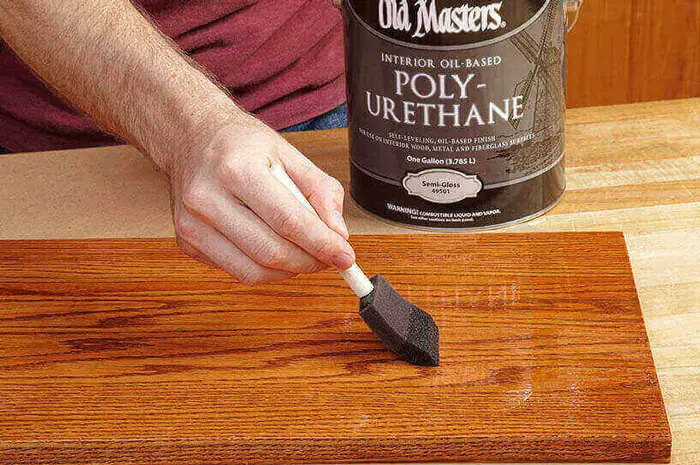How Long Does Polyurethane Take To Dry? Explained!
Polyurethane is a top choice for creating a protective and appealing finish for your projects. It can be used to improve the visual appeal of surfaces while also protecting them.
But how long does polyurethane take to dry? The drying time of polyurethane depends on the type used. Water-based polyurethane typically dries to the touch in 2 to 4 hours, whereas oil-based polyurethane requires more time, taking 8 to 24 hours for a single coat.
However, keep in mind that these are only the initial drying phases; complete curing will take longer. This article will give you a thorough understanding of polyurethane drying times. You’ll also learn the different factors that affect drying time and actionable tips for accelerating drying.
How Long Does Polyurethane Take To Dry?

When it comes to polyurethane drying time, there are two types to consider: water-based and oil-based. Because of their distinct compositions and chemical properties, the drying times of these two formulations differ.
1. Drying Time of Water-Based Polyurethane
This type of polyurethane typically dries to the touch in 2 to 4 hours after application. This rapid drying is due to the water content in the formulation, which evaporates faster than the solvents found in oil-based polyurethane.
It is important to note that the initial drying phase is not the same as full curing. While the surface may appear dry, it is best to wait at least 24 hours before applying a subsequent coat.
2. Drying Time of Oil-Based Polyurethane
It can take anywhere from 8 to 24 hours for a single coat of oil-based polyurethane to dry. Mineral spirits or other oil-based solvents are used in this synthetic, which evaporates at a slower rate, resulting in a longer drying time.
Waiting at least 24 hours between coats is recommended, as with water-based polyurethane.
Factors Affecting Polyurethane Drying Time

Several key factors influence the drying time of polyurethane coatings. They include:
Humidity Levels
Elevated humidity levels can cause polyurethane to take longer to dry. This is especially true for oil-based polyurethane, as higher humidity prevents solvent evaporation.
As a result, it’s best to apply polyurethane on days when the humidity is low. When applying polyurethane, aim for 40% to 60% humidity.
Temperature Conditions
Warmer temperatures help polyurethane coatings dry faster. Extreme heat, on the other hand, can have a negative impact, causing the polyurethane to dry too quickly and potentially resulting in cracks or uneven finishes. Aim for a temperature of around 70°F (21°C) for optimal drying.
Ventilation and Airflow
Proper ventilation is essential when working with polyurethane coatings, especially oil-based variants. This is because polyurethane contains VOCs, which are particularly harmful to your health.
Additionally, good airflow speeds up drying. Ensure your workspace is well-ventilated, either by using fans or working in an area with open windows.
Coating Thickness
Applying thin, even coats of polyurethane is essential for achieving faster drying times. Thin coats allow solvents to evaporate more quickly, speeding up the overall drying process. Thin coats are also less prone to developing uneven finishes or bubbles.
Wood Species
Hardwood surfaces absorb polyurethane more slowly than softwood surfaces. Hardwoods like oak, maple, and cherry have denser and less porous structures than softwoods like pine or cedar.
Because hardwoods have a lower porosity, polyurethane can sit on the surface longer before being absorbed, slightly extending drying time.

Nature of Wood Surface
Because of the open grain structure, a sanded surface absorbs polyurethane more readily. When wood is sanded, its pores open up, allowing the polyurethane to penetrate. This potentially leads to a slightly shorter drying time.
Presence of Stain or Natural Oils
Stained wood or wood with natural oils may have a slower absorption rate. It’s important to take into account any pre-existing treatments on the wood when planning on applying polyurethane.
Method of Application
Applying polyurethane with a wipe-on or spray-on method often results in a thinner and more even coat. Thinner coats tend to dry more quickly due to efficient solvent evaporation.
Brushing or rolling on polyurethane can result in slightly thicker coats. Thicker coats can extend drying times, as more solvent needs to evaporate for the polyurethane to dry and cure properly.
Sheen Type
Gloss and semi-gloss finishes dry slightly slower than matte and satin finishes. The higher levels of resins in gloss and semi-gloss formulations can lead to slightly longer drying times. Satin finishes have the fastest drying time.
Tips On How To Speed Up Polyurethane Drying Time

There are practical steps you can take to accelerate the drying time of polyurethane coatings when time is of the essence.
Applying Extra Heat
Gentle heat can hasten solvent evaporation, shortening the drying time of polyurethane. Excessive heat, on the other hand, should be avoided as it can cause premature drying and uneven finishes. To provide a mild boost in drying speed, use a hairdryer on a low setting or an infrared heater with caution.
Using a Dehumidifier
Reducing humidity levels in your workspace can significantly accelerate the drying process. Use a dehumidifier to reduce moisture in the air, allowing solvents to evaporate more efficiently.
Using a Thinner
Adding a compatible thinner, such as Naphtha, to your polyurethane can help reduce viscosity and increase solvent evaporation. This allows for faster drying without compromising the finish’s integrity.
However, following manufacturer guidelines and ensuring proper compatibility before adding any thinners is critical.
Applying Polyurethane on a Sunny Day
Natural sunlight and warmth can contribute to faster drying times. Working on a sunny day with adequate ventilation can promote efficient solvent evaporation.

Be Mindful of the Wood Surface
A properly prepared surface promotes faster drying. Make sure the wood surface is clean, free of debris, and sanded to the desired level of smoothness. A smooth surface with open grains allows for more even absorption, which can lead to faster drying.
Using Water-Based Polyurethane
As mentioned, water-based formulations generally dry more quickly than their oil-based counterparts. This can be especially advantageous when time is a critical factor.
Using Fast-Drying Polyurethane
Fast-drying polyurethane products are designed to shorten drying times without sacrificing finish quality. These formulations contain additives that promote rapid solvent evaporation.
How Do You Know Polyurethane is Dry?

Here are a few ways to identify whether polyurethane is dry.
- Tactile Test: Gently touch the polyurethane-coated surface with the back of your hand. If it feels cool to the touch and doesn’t leave an imprint, it’s likely dry.
- Visual Inspection: Inspect the surface for a uniform sheen. Wet polyurethane appears glossy and uneven, while dry polyurethane has a consistent matte or semi-gloss finish.
- Thumb Test: Press your thumb lightly onto the surface. If your thumbprint leaves a mark, the polyurethane is not fully dry. If it doesn’t leave a mark, it’s likely dry.
- Time Test: You could also wait for the time recommended for the type of polyurethane you’re using.
How Long Does Polyurethane Take To Cure

Drying refers to the time it takes for the solvents or water content in the polyurethane to evaporate, leaving the surface touchable. Conversely, curing is the period required for the polyurethane to chemically bond and harden, resulting in a durable finish.
| Activity | Water-Based Polyurethane | Oil-Based Polyurethane |
|---|---|---|
| Ready for Another Layer | 2-4 hours | 8-24 hours |
| Dried to Touch | 2-4 hours | 8-24 hours |
| Placing Things on the Surface | 24 hours | 72 hours |
| Fully Cured | 7 days | 30 days |
FAQs
Let’s check out some commonly asked questions regarding polyurethane drying time.
Q1. Why won’t my polyurethane dry?
Several factors can contribute to polyurethane not drying as expected. Examples of these factors are:
- High humidity
- Low temperatures
- Thick coats
- Poor ventilation
- Using old or contaminated products
- Applying coats too quickly
Identifying the specific cause of the issue will help you address it and achieve proper drying.
Q2. Can you sleep in a house immediately after polyurethane?
Sleeping in a freshly polyurethane-coated area is generally not advised immediately after application. Polyurethane emits fumes during the drying and curing processes that can be harmful if inhaled. So, it is recommended that you wait until the polyurethane is completely dry.
Q3. How durable is polyurethane?
Polyurethane is well-known for its exceptional durability and ability to provide long-lasting protection to a variety of surfaces. When it fully cures, polyurethane forms a tough and resilient protective layer that can withstand daily wear and tear, moisture, scratches, and even mild chemicals.
Conclusion
Water-based polyurethane dries in 2-4 hours and cures in 7 days, whereas oil-based polyurethane takes 8-24 hours to dry and 30 days to cure. Understanding the factors influencing drying time and creating an optimal drying environment is critical for achieving the best results.
Remember that patience is essential, as the curing process takes longer than the initial drying. By following these guidelines, you can ensure a successful polyurethane finish that improves the durability and aesthetics of your projects.




